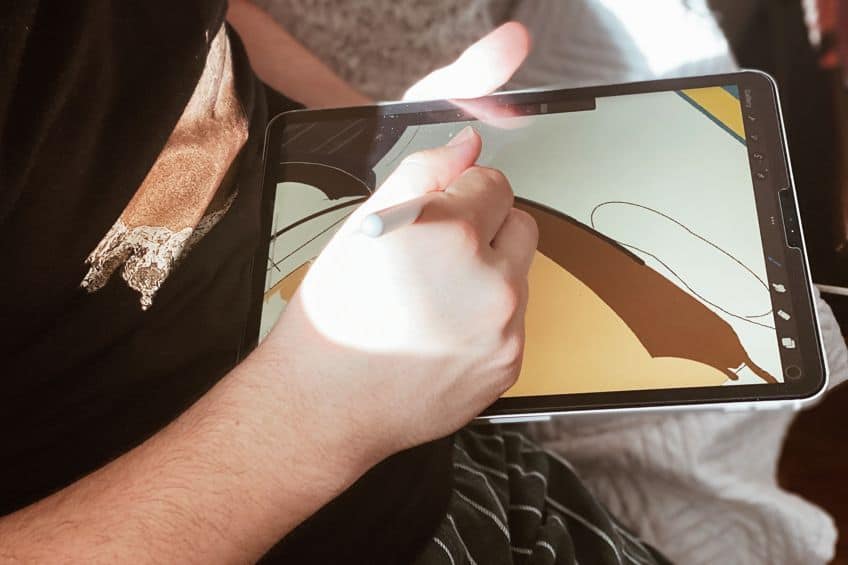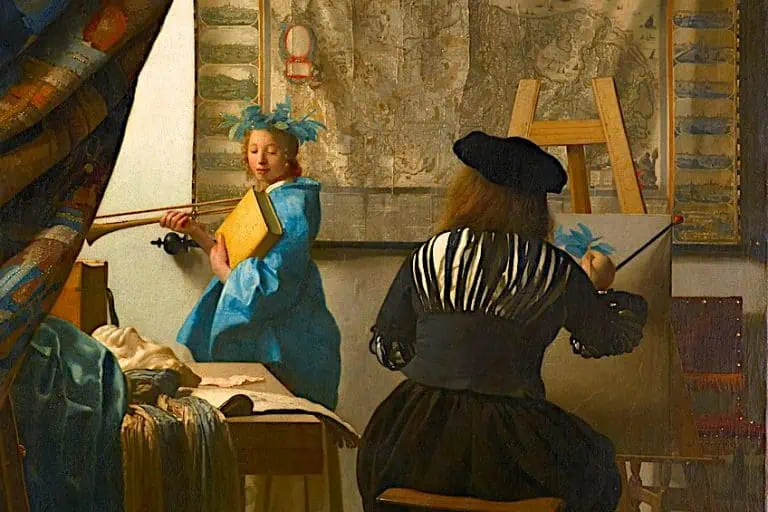How to Sell Digital Art – A Guide to Nurturing Your E-Portfolio
This post may contain affiliate links. We may earn a small commission from purchases made through them, at no additional cost to you.
Many talented artists get to a point in their careers where they want to know how to make money with digital art. Selling digital prints online can turn into a lucrative source of income if you know how to engage with the tools and industry. But what does selling digital art entail? In this article, we shall show you how to sell digital art and where to sell digital art, so join us below to learn more!
Table of Contents
- 1 How to Sell Digital Art
- 2 Selling Digital Art
- 3 Finding Your Digital Art Niche
- 4 Creating Your Digital Art
- 5 Creating Compelling Digital Art to Sell
- 6 How to Protect Your Digital Art
- 7 Setting Prices for Your Digital Art
- 8 Increasing Your Online Presence
- 9 Where to Sell Digital Art
- 10 Frequently Asked Questions
How to Sell Digital Art
Many creative individuals nowadays are aware of the numerous opportunities that digital art provides, from acquiring online popularity to launching a company or even developing a community around them. After the Covid pandemic, major job losses, and the development of small enterprises, cryptocurrencies, and online work platforms, it has become very apparent that digital art offers multiple ways to promote yourself to the general public.

The most rewarding part of being a web-based artist is developing a distinct art style, honing your creative abilities, and getting your work seen by other people, but you won’t succeed on exposure alone. You should never undervalue your abilities or let them go to waste. Selling digital art is the ultimate goal if you wish to make it as an artist in this day and age.
Let us find out how to make money with digital art below.
Selling Digital Art
Digitization has transformed the art world, presenting fresh challenges from a range of viewpoints: new technology has increasingly infiltrated the realm of art, both in the creative act and in the selling of the artwork itself.
The new Art Market responds to these changes by overcoming previous strategies and establishing new connections among all those involved.
There has been a gradual development in the art world throughout history: every societal transformation is accompanied by new ideas of production and approach to art. Now, the trend of democratization of art is accelerating in conjunction with the technological revolution, allowing it to reach the homes of potential customers with a single click.
The Advantages of Selling Digital Prints Online
Compared to the more traditional methods of selling art, selling digital art has several distinct advantages. Artists have access to a worldwide audience through online channels, which eliminates any geographical restrictions. Artists are able to communicate with potential consumers from all around the world, improving their visibility and potential revenue. Selling digital art gets rid of the necessity for the physical production of the art, as well as packaging, and shipping costs. This lowers your overhead costs and enables you to take home a larger share of the artwork’s sale price.
Online platforms also enable you to promote and sell your digital artwork 24 hours a day, seven days a week.
Potential buyers are thus able to explore and buy your digital artwork from the convenience of their own homes at any time they wish. Direct connection between artists and consumers is also facilitated by these digital art platforms.

This allows artists to discuss their process of creation, address questions, and create connections with potential customers, resulting in a more personal connection than is available at a gallery or exhibition. Another benefit of selling digital art online is that the sale of these works on online platforms provides you with the opportunity to generate a passive income.
Once artwork has been uploaded and is ready to be bought, it can keep on generating income without you having to put in effort constantly.
The Disadvantages of Selling Digital Art
Your digital art can easily be reproduced, distributed, and altered without your consent. It can be very difficult to protect your digital artwork’s copyright, and you can expect to encounter many examples of unauthorized use. The ease of use of digital art platforms has resulted in an increase in the number of artists offering their work to customers online. As a result of this, competition has greatly intensified, which has made it harder for individuals to stand out and get recognized among the thousands of other artists out there.
Choosing the right price for your digital art is also challenging when you start out.
The fact that digital data is not physical, along with the lack of scarcity associated with physical art, this can make determining the worth of your digital artwork difficult, and perhaps leading to problems with pricing and undervaluing your work. Questions of authenticity can also occur in the digital art industry due to the ease of duplication and modification. Buyers could be worried about the originality of digital artwork, which could affect their desire to purchase a piece.

Finding Your Digital Art Niche
Next, we shall discuss how to find your digital art niche. This can also be applied to finding your niche in any type of art. Discovering your niche is the first step to getting your digital artwork out there. A theme is a core concept or statement behind your artwork. This might be something close to your heart, such as supporting women’s rights and encouraging them to feel confident and attractive. Yet, it doesn’t have to be some global issue, it might be something as simple as creating art that makes people smile and your theme can be as obvious or as subtle as you like.
The next thing to think about is what subjects you like to portray. This could be a landscape, portraiture, dolls, animals, literally whatever you enjoy making.
When we talk about style, it usually refers to how you create your artwork. This includes technical details such as shape, color palette, language, and composition. When it comes to finding your creative niche style, we may think of style as a “label” or moniker that those who follow you will recognize. The medium is the actual materials that you use to produce your artwork. It could involve whatever you enjoy using to create art, from digital art to oil paintings.

The medium part of your niche is the most adaptable, so don’t feel obligated to keep to just one, although it might be beneficial to start with one or two. The “use” factor describes how buyers will utilize your artwork after it is finished. It could, for example, be used for tattoos, magazine and book illustrations, and even for pieces in a gallery or exhibition. At the end of the day, it comes to asking yourself what you enjoy creating.
This question allows you to consider what styles, themes, and subjects you have the greatest attraction to. Your responses to this question will serve as the foundation for your specialization in art and help you find your niche.
Examine your present work to determine if there is a common theme that runs throughout. If not, no worries! You can experiment with several options until you discover what feels perfect for you. To make a livelihood in digital art, you don’t have to be the best at it, but you do have to be sufficiently good that others will pay you for your efforts.
Finding Your Target Audience
Once you’ve identified your unique artistic style, subjects, and approaches, you can begin to identify the characteristics that set your digital art apart. This will help you in determining your target audience’s tastes and preferences. You could also do some research on the prevalent digital art platforms to learn about customer interests, demographics, and preferences. Visit online art groups and marketplaces to learn about the sorts of digital art that appeal to diverse audiences. It’s also a good idea to interact with your current audience or prospective customers via social media and online forums.
Publish your work and pay attention to the feedback that you get. This can provide you with the necessary insight into your audience.
You can also try tracking your audience’s demographics and behavior using analytics tools accessible on social networking networks and other websites. These analytics will provide you with useful information about your audience’s age range, geographic region, and engagement behavior. Then you can begin to refine your unique style or experiment with new subjects or approaches that correspond with the tastes of your target audience based on the insights obtained.

Try to get feedback on a regular basis and evaluate the reaction to determine what connects most with your target demographic. You can also find and join specialized groups that share your artistic style or subjects. Actively engaging in these forums may help you network with and gain attention from your target audience. Remember that defining a specific target demographic does not preclude other possible purchasers from being considered.
It simply assists you in focusing your marketing efforts and adapting your approach to appeal to a certain set of art fans who are most likely to enjoy and buy your digital art.
Creating Your Digital Art
Making digital art can be a very gratifying experience. Some individuals just do it as a fun pastime, while others wish that they could make it their full-time job. If you are just starting out with making digital art, then check out our list of all of the essential tools that every digital artist should have in their toolbox.
Drawing Tablet
A drawing tablet is a common tool in the arsenal of every digital artist. A standard mouse is incapable of drawing complex designs. Furthermore, they lack pressure sensitivity, which is vital for creating digital art. Drawing tablets provide you with complete control and feel just like sketching with a pencil. Having said that, drawing tablets are not prohibitively pricey, so one can easily buy a good drawing tablet on a budget. There are two types of drawing tablets.

The first one is called a graphics tablet and is an input device that enables you to draw directly on the surface of the tablet while seeing the results on a separate display. They lack an in-built display and must be connected to a PC or laptop. Graphics tablets are often less expensive and have a wider range of possibilities, making them suited for both beginning and experienced artists. Pen display tablets, on the other hand, do have an in-built screen that directly displays your artwork on the tablet. These tablets enable you to draw right on the screen, replicating a more natural experience.
Digital Art Software
Digital art software is an essential tool for digital artists since it offers a digital canvas as well as a number of tools and functions for creating, editing, and enhancing your artwork. Adobe Photoshop is a popular and flexible tool for digital art creation. It includes an assortment of tools and capabilities for making digital artwork, such as drawing, painting, picture editing, and graphic design. Layers, brushes, customized brushes, filters, and blending modes, as well as other advanced functions, are all supported by Photoshop.
Corel Painter is software that was created primarily for digital painting and emulating traditional creative materials.
It includes a large number of lifelike tools and brushes that mimic the texture and behavior of art materials like oil paint, watercolors, and even pastels. Procreate is yet another popular piece of software for drawing made for the iPad that is noted for its powerful and user-friendly interface. It has a large selection of different brushes, blending modes, and even advanced functions such as animation support. Procreate is well-known for its intuitive sketching experience and reactivity.

Krita is an open-source and free digital painting program with a plethora of features and options for artists. It has a user-friendly interface, a variety of customizable brushes, blending modes, and complex brush engine settings. Krita is well-known for its huge community support and ongoing development. Clip Studio Paint is a feature-rich program that illustrators and comic artists typically utilize. It includes a variety of tools and functions for sketching, inking, coloring, and making comic panels.
Clip Studio Paint includes tools for making comic and manga art such as perspective speech bubbles, rulers, and panel generation.
Color Accurate Monitors
Digital painting is all about selecting the appropriate colors and effectively blending them. Consequently, getting the proper colors from your display is critical. Many low-cost computer displays are incapable of producing industry-standard professional colors such as AdobeRGB. Furthermore, these screens do not have adequate viewing angles. The brightness and contrast settings are likewise low, resulting in poor images. Therefore, it is crucial to invest in a decent monitor that supports the AdobeRGB color scheme. Good display monitors have high brightness levels, high contrast ratios, and wide viewing angles.

Shortcut Remotes
When sketching, you seldom require all of the shortcut combinations at once; instead, you often utilize a few keyboard keys repeatedly. In these cases, the Shortcut remote can be extremely useful. Not long ago, there were only a few shortcut remotes accessible for artists, and most of them were subpar. However, in recent years, we’ve witnessed an increase in the number of shortcut controllers designed expressly for digital artists by drawing tablet manufacturers.
These remotes are extremely configurable and have a user-friendly design.
Adequate Computer
Although a standard PC is adequate for digital painting, when working on a huge canvas size or with highly styled brushes, problems begin to develop. Sometimes, the machine will freeze or the application will crash. It may also cause a significant sluggishness on the computer, with each stroke appearing a few seconds after you draw it. Buying a decent PC addresses all of these problems. It enables you to focus on generating new artwork rather than having to spend all your time troubleshooting.

A Decent Chair
Making art or working on a project all take a significant amount of time. It is fairly usual for artists to work long hours. Having poor posture or utilizing a low-quality chair could lead to exhaustion. Have you ever wondered why all gamers have expensive chairs? It’s because they are meant to provide you with a pleasant working environment and to keep your posture in check. They offer lumbar support, neck support, optimized cushioning, and adequate ventilation.
They make your life simpler and may ultimately prevent you from lifelong neck or back pain. As a result, it is prudent to invest in a decent working chair.
Creating Compelling Digital Art to Sell
If you want to make good digital art, you first need to develop a solid foundation in traditional art concepts such as perspective, composition, color theory, and anatomy. Having a basic understanding of these concepts will provide you with a strong foundation for creating aesthetically appealing digital art. It’s also a good idea to examine multiple artistic styles in order to discover your distinct visual voice.
Try experimenting with different textures, brush types, and effects to create unique and compelling images that reflect your artistic vision. Textures may be used to bring depth and aesthetic appeal to your digital creations.
You can try experimenting with various overlays, brushes, and texture brushes to imitate varied surfaces such as skin, cloth, or natural components. Textures also help to improve your artwork’s realism. To make your artwork more intriguing, pay attention to little details and subtleties. Intricate patterns, complicated textures, tiny lines, and finely drawn sections may all contribute to the overall look of your digital artwork.

Make digital art that conveys a specific message. Consider the story, characters, or ideas you want to represent, and then employ composition, poses, and visual components to convey the message you want to convey or elicit a certain response from the viewer. Remember that the most captivating digital work often requires a mix of technical skill, aesthetic vision, and individual expression.
Don’t be afraid to push the boundaries of your creativity on a regular basis to build a distinct style and create work that connects with your audience.
How to Protect Your Digital Art
The first step to protecting your digital art is understanding what your intellectual property rights are. You automatically own the copyright to your original digital artwork as the creator. You have the sole right to reproduce, distribute, exhibit, and make other works based on your artwork under the terms of copyright. To improve your legal protection, however, it is advised that you mark your creations with the copyright sign, along with your name, and the year of production. You might also want to think about registering your work with your country’s proper copyright office, which will offer you further legal protection.
Fair use is a legal concept that allows for restricted utilization of copyrighted content without the copyright holder’s consent.
Fair use includes uses that include commentary, criticism, education, and parody. When someone uses, copies, or spreads your intellectual property without your permission, this is considered an infringement. If you detect infringement, you have legal options, such as mailing a cease-and-desist letter, launching legal action, or requesting monetary compensation from the offending parties. Digital watermarks can be included in your artwork to identify and trace its ownership. They can prevent unauthorized usage and offer proof in the event of copyright infringement. Metadata protection is an additional step you may take to protect your artwork and assert your rights.
Metadata is descriptive data contained within a digital file that offers information about the piece of work, such as copyright information and authorship. Metadata may be used to offer a description of your artwork as well as important keywords to assist identify and categorize the pieces you create. This can improve searchability and help people properly credit or license your art. It’s a good idea to also include specific usage rights or limits for your work in the metadata, such as non-commercial use only or modification restrictions.
It clarifies how people may use your artwork and further protects your rights.
Setting Prices for Your Digital Art
Once you have created your art and put all the necessary copyrights in place, you can then decide on what your pricing will be for your digital artwork. Deciding on the correct price for your art will be determined by a few factors. You need to factor in how much time and effort you put into creating the artwork. Pricing can be influenced by factors like complexity, degree of detail, and talent required. The perceived worth of your digital work may be influenced by your artistic experience, fame, and status in the art world. Established artists with a large following often charge greater rates.

If your digital work has a particular style or stands out for its uniqueness, it may deserve a greater price since it offers something distinctive and desirable to collectors. Assess any expenses related to the creation of your digital work, such as software, equipment, or licensing fees. Consider these factors while determining your rates to guarantee that you pay your expenses while still making a healthy profit. Think about modifying prices if you want to sell limited editions or provide exclusive access to particular artworks. Limited availability might boost your digital art’s perceived worth.
Choosing a Price Model for Selling Digital Art
Setting a fixed price for your digital work that applies to all consumers is what fixed pricing entails. This approach ensures consistency and streamlines the purchasing process. Tiered pricing provides distinct cost tiers based on the sort of digital art, its resolution, or the buyer’s usage permissions.
This enables you to accommodate various consumer budgets. You might also think about selling your digital work using auction sites or bidding systems.
This concept encourages customers to compete for your artwork, thereby increasing the price while providing the impression of exclusivity. If you regularly create digital art, you can provide a subscription model in which users pay a monthly price for access to your continuing work. This can create a consistent cash stream as well as a loyal consumer base.
Choosing a Payment Method
You should also accept payments from your customers safely and easily using prominent online payment services like PayPal, Square, or Stripe. These sites accept bank transfers, credit cards, and digital wallets as payment methods. Consider adopting cryptocurrencies as a payment option, especially if your target audience likes or actively utilizes these digital currencies. If direct bank transfers are widely utilized in your target market, offer clients the opportunity to use them.

Make sure you have a safe and dependable system in place to handle these transactions. If you plan to sell your digital work through online platforms, be sure the payment options they provide meet your needs. To make the purchase of higher-priced artworks easier to make to purchasers, think about providing payment plans or installment alternatives. To minimize misunderstandings, clearly clarify the payment plan’s terms and restrictions.
Increasing Your Online Presence
Make an appealing user-friendly website that can be used as a portfolio for your greatest digital artworks. Using WordPress, you can build your own website and include the WooCommerce plugin to provide e-commerce features. On your website, include an artist statement part to identify yourself, your artistic history, motivation, and aesthetic vision. Visitors to your website will be able to connect with you on a more personal level as a result of this.
It is important that you provide straightforward contact information, such as your email address, to make it easier for visitors to reach you.
This enables potential customers, clients, or fellow artists to contact you with questions or to collaborate on projects. Another cool idea is to include a news section or blog where you can post updates on your works in progress, behind-the-scenes information, tutorials, or views on your artistic process. This helps to increase audience engagement with your site. Make sure that it is mobile-friendly and search engine optimized. Responsive design helps your website to adjust to multiple devices, providing users with a smooth browsing experience.

Where to Sell Digital Art
Besides marketing your art from your own website, there are also many online sites that serve as platforms for selling digital art online. Digital art is available on the well-known online store Etsy, which sells handcrafted and original products. Society6 specializes in providing lifestyle items, and home goods, and selling digital prints online.
Redbubble sells a variety of items displaying the artwork of artists, such as clothing, accessories, and home décor.
Concept art, illustrations, and game graphics are the primary areas of focus on the site ArtStation, which is devoted to displaying and selling digital artwork. DeviantArt is a website run by the community where artists may share and market their digital artwork, connect with other digital art creators, and take part in various online competitions. In order to develop and market goods that feature their digital art, artists can use Printify’s print-on-demand services. A well-known e-commerce platform called Shopify offers artists a simple-to-use interface for creating and customizing their online storefronts.

Now you know how to sell digital art successfully! By applying the steps mentioned above, learning how to make money with digital art can be both easy and fun. As with any career choice, it just takes a bit of research and time to figure out how to get your foot in the door and become a profitable digital artist. Selling digital art has never been easier than it is right now, so go out there and start making money from your art!
Frequently Asked Questions
How Do I Sell My Digital Artworks Online?
At present, there are many ways to sell your own digital artwork online. One of the best ways to reach your audience is to use social media and to have a website where people can visit and see your work. This site will serve as your digital art portfolio. There are also many online platforms that will allow you to showcase your works on their site.
Where Do I Learn How to Sell Digital Art?
Many online sites provide classes and courses designed exclusively for selling digital art. These classes include subjects such as creating an online presence, using promotional strategies, setting prices, and grasping the market for digital art. Numerous websites, like Skillshare, Udemy, and Coursera, regularly offer relevant courses. Participating in online groups and forums devoted to digital art or the art industry could give you access to insightful advice from seasoned experts and artists.
In 2005, Charlene completed her wellness degrees in therapeutic aromatherapy and reflexology at the International School of Reflexology and Meridian Therapy. She worked for a company offering corporate wellness programs for several years before opening her own therapy practice. In 2015, she was asked by a digital marketer friend to join her company as a content creator, and it was here that she discovered her enthusiasm for writing. Since entering the world of content creation, she has gained a lot of experience over the years writing about various topics such as beauty, health, wellness, travel, crafting, and much more. Due to various circumstances, she had to give up her therapy practice and now works as a freelance writer. Since she is a very creative person and as a balance to writing likes to be active in various areas of art and crafts, the activity at acrylgiessen.com is perfect for her to contribute their knowledge and experience in various creative topics.
Learn more about Charlene Lewis and about us.







